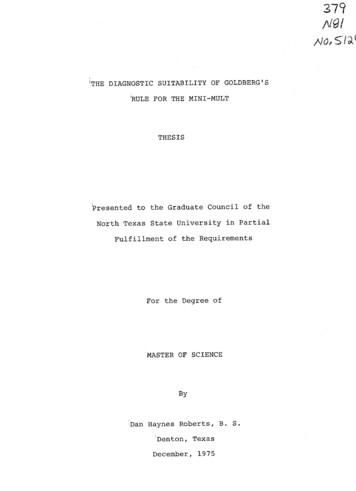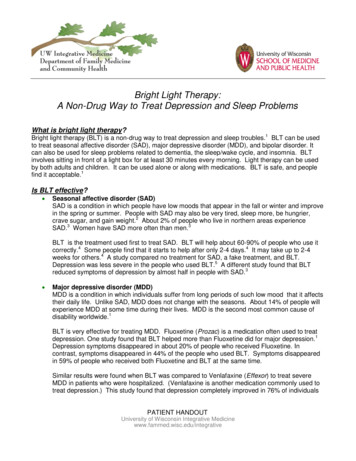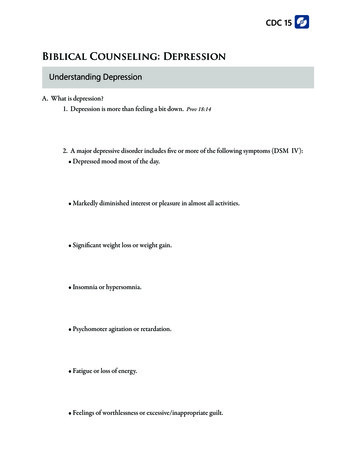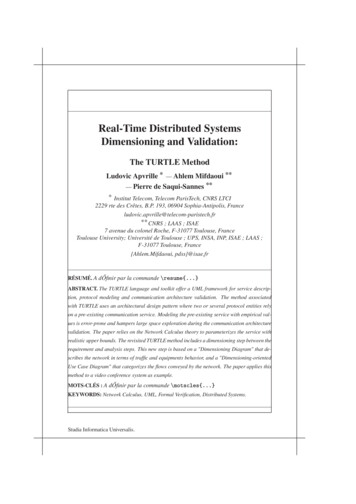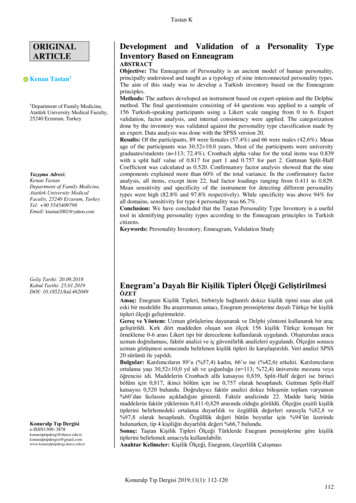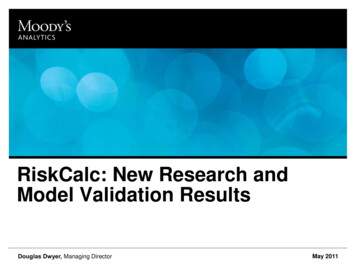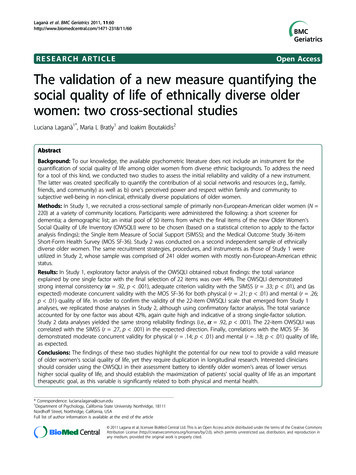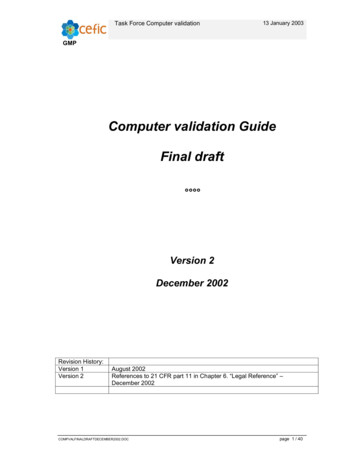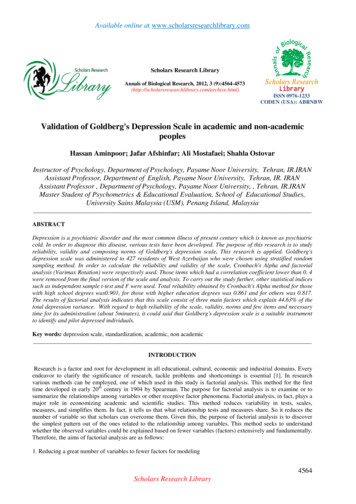
Transcription
Available online at www.scholarsresearchlibrary.comScholars Research LibraryAnnals of Biological Research, 2012, 3 rchive.html)ISSN 0976-1233CODEN (USA): ABRNBWValidation of Goldberg's Depression Scale in academic and non-academicpeoplesHassan Aminpoor; Jafar Afshinfar; Ali Mostafaei; Shahla OstovarInstructor of Psychology, Department of Psychology, Payame Noor University, Tehran, IR.IRANAssistant Professor, Department of English, Payame Noor University, Tehran, IR. IRANAssistant Professor , Department of Psychology, Payame Noor University, , Tehran, IR.IRANMaster Student of Psychometrics & Educational Evaluation, School of Educational Studies,University Sains Malaysia (USM), Penang Island, MalaysiaABSTRACTDepression is a psychiatric disorder and the most common illness of present century which is known as psychiatriccold. In order to diagnose this disease, various tests have been developed. The purpose of this research is to studyreliability, validity and composing norms of Goldberg's depression scale. This research is applied. Goldberg'sdepression scale was administered to 427 residents of West Azerbaijan who were chosen using stratified randomsampling method. In order to calculate the reliability and validity of the scale, Cronbach's Alpha and factorialanalysis (Varimax Rotation) were respectively used. Those items which had a correlation coefficient lower than 0. 4were removed from the final version of the scale and analysis. To carry out the study further, other statistical indicessuch as independent sample t-test and F were used. Total reliability obtained by Cronbach's Alpha method for thosewith high school degrees was0.901, for those with higher education degrees was 0.861 and for others was 0.817.The results of factorial analysis indicates that this scale consist of three main factors which explain 44.63% of thetotal depression variance. With regard to high reliability of the scale, validity, norms and few items and necessarytime for its administration (about 5minutes), it could said that Goldberg's depression scale is a suitable instrumentto identify and pilot depressed individuals.Key words: depression scale, standardization, academic, non academicINTRODUCTIONResearch is a factor and root for development in all educational, cultural, economic and industrial domains. Everyendeavor to clarify the significance of research, tackle problems and shortcomings is essential [1]. In researchvarious methods can be employed, one of which used in this study is factorial analysis. This method for the firsttime developed in early 20th century in 1904 by Spearman. The purpose for factorial analysis is to examine or tosummarize the relationships among variables or other receptive factor phenomena. Factorial analysis, in fact, plays amajor role in economizing academic and scientific studies. This method reduces variability in tests, scales,measures, and simplifies them. In fact, it tells us that what relationship tests and measures share. So it reduces thenumber of variable so that scholars can overcome them. Given this, the purpose of factorial analysis is to discoverthe simplest pattern out of the ones related to the relationship among variables. This method seeks to understandwhether the observed variables could be explained based on fewer variables (factors) extensively and fundamentally.Therefore, the aims of factorial analysis are as follows:1. Reducing a great number of variables to fewer factors for modeling4564Scholars Research Library
Hassan Aminpoor et alAnnals of Biological Research, 2012, 3 (9):4564-45732. Selecting a subtest from a large number of items that have the highest coefficient with the main components3. Producing a collection of factors as uncorrelated variables so that the so-called could be close4. Validating a scale or index by means of determining the load of the components of the scale on extracted factors5. Preparing multiple tests which measures only one factor and requires administration of fewer tests.6. Determining clusters of the subjects7. Determining groups by selecting those people who are classified in a cluster [2]The movement of mental measurement was introduced in late 19th century by Galton and then developed further byother researchers. Without doubt, one of psychology's contributions to the society is the assessment of ideas andpsychological variables [3]. Today measuring mental characteristics is one of the most important activities ofpsychologists. In fact, there are very few people who have not undergone mental measurement during their life time.Therefore, developing suitable measurement instruments, and having standards and norms appropriate toeducational and cultural status of the society cannot be avoided [4].Since depression is the most common mentaldisease of the present century [5], it is regarded as the most serious illness of the century and according to HarvardUniversity report, it will hold the first or second rank among common diseases until 2020 [6]. As a result,diagnosing this disease is essential because the sooner and cheaper depressed people are identified, the morevaluable the standardization of the scale is.MATERIALS AND METHODSSubjectsOut of West Azerbaijan residents a sample consisting of 427 were selected using stratifies random sampling method.Descriptive indices related to sample under study are presented in Table 1.This research is applied. In order to calculate the reliability and validity of the scale, Cronbach's Alpha and factorialanalysis (Varimax Rotation) were respectively used. For each single item mean and SD were calculated and thoseitems which had a correlation coefficient lower than 0. 4 were removed from the final version of the scale andanalysis. Also, categorical and percentile norms were calculated.Table 1: Descriptive indices of the sample under studyVariableStatisticFrequencyPercentile FrequencyResidentUrban Rural3873990.69.1EducationHigh school Academic14214133.333.0other14433.7GenderMale Female19523245.754.3MeasuresIn order to study the variables, the researchers used Goldberg's depression scale. This scale consists of 18 itemswith 6 choices. For choice (to a great extent) score 5, choice (a lot) score 4, choice (quite a lot) score 3, choice(partly) score 2, choice (only slightly) score 1 and choice (not at all) score 0 are allocated. The more total scores are,the higher depression level will be. It should be mentioned that every individual can take this test frequently toassess his/her mental status. Every subject's mental status could be calculated based on Table 2.Table 2: Subjects status with regard to raw score before standardization of the scaleNo123456Score0-910-1718-2122-3536-5354 StatusDepression unlikelyPossibly minor depressionOn the verge of depressionMinor to moderate depressionModerate to severe depressionSevere depressionWhen the total score is over 21, the individual should refer to health experts for examination and necessarytreatment.RESULTS AND DISCUSSIONReliability of Goldberg's depression scale: Reliability is dependability, consistency, and repeatability of results formeasuring information and characteristics [7]. Reliability of a test refers to the agreement of its assessors orachieving similar results under similar circumstances [8]. On the other hand, the size of the sample instandardization is one of researchers' concerns which should be big enough and represent the sample population.4565Scholars Research Library
Hassan Aminpoor et alAnnals of Biological Research, 2012, 3 (9):4564-4573Table 3: Mean and Standard Deviation of each item of the depression 1.641.581.551.581.681.641.541.71Number of 427427427427What is important is the precision, stability, and reliability, more broadly the degree of the reliability of the test .i.e.if an individual is reassessed by an instrument, to what extent it is possible to replicate, retrieve and repeat the sameresults. Reliable measurement means every individual's position should be kept consistent in relation to other peoplein his/her group. An indicator of this issue is a small standard error of measurement or a big reliability coefficient.One of the methods to calculate the reliability of the test is Cronbach's alpha. This method is only used in testswhich have homogenous and similar items and all of them are used to assess one single characteristic. Here theanalysis in this assessment is based on the assumption that all the items are indices of one basic characteristics, i.e.test is homogenous in terms of content.Table 4: Descriptive indices of each item in relation to the whole test if items are removedItem123456789101112131415161718Total mean ifitems al varianceif items removedRelationship betweenitems and the whole testTest reliability ifitems 2.852.865If the test consists of two or more different subtests, it is essential that the analysis of each subtest be doneseparately, and to calculate total reliability of the test, one should use summation correlations. When homogenousassumption is true, this method is, perhaps, the most concrete means to determine harmony of the items [9].Descriptive indices of the items of the test under study are presented in 3. Likewise, descriptive indices of the meanof the whole test, total variance of the test, and reliability of the test in the event of removing items regarding totaltest are presented in Table 4. Also, correlation coefficient of each item with total score of the test is shown in Table5.4566Scholars Research Library
Hassan Aminpoor et alAnnals of Biological Research, 2012, 3 (9):4564-4573Table 5: Pearson correlation coefficient of each item with total score of the on correlation Significance ificance level 0.01 (two-tailed) 427427427427427According to the Table 5, Pearson correlation coefficient of each item with total score of the test indicates that all ofthe items have positive correlation coefficient with total score of the test. Items 12 and 16 have the correlationcoefficient 0.666 and 0.671 respectively with total score. Table 6 displays reliability correlation of the test and itsfactors by means of Cronbach's alpha method.Table 6: Reliability correlation of the test and its composing factorsEducation levelFactor 1High schoolAcademicOtherTotal subjectsNumber of itemsSadness &lack ofinterest in life0.903.838.804.85512Reliability of the test (α)Factor 2Factor 3DisappointmentInability in decision making.440.351.354.3833.688.628.366.5693Number of subjectsTotal scoreof ults obtained for the whole test indicates that Goldberg's depression scale has a high level of reliability to carryout research and counseling.Validity of depression scaleTest validity means what the test measures and to what extent it is effective. It should be noted that the name orlabel of a test does not show what it measures. In fact, the names of tests are only short labels to identify them.Although at present researchers try increasingly to choose exclusive names based on practical applications, thenames of most tests are so broad and obscure that they require clear guidelines in the behavioral domain of the testconstruction. By only examining the objective sources of information and empirical operations done to diagnose testvalidity it is possible to define a particular trait that the test assesses [10]. Construct validity is one method ofvalidating the instrument used in present study. To put it simply, construct validity means comparing the results ofthe administration of the instrument with those predictions achieved based on a theory or other known facts. A traitor traits assessed by a test or a questionnaire is an abstract characteristic that cannot be assessed directly. Butwithout doubt there is a theory for that trait at a higher level. A theory related to a particular trait shows what kind ofvalidity is appropriate to reveal that trait. Construct validity put more emphasis than other validity on broaderbehavioral descriptions, more stable and more abstract. It requires gradual gathering of information from differentsources and it takes into account whatever data that displays the nature of characteristic and effective circumstancesin its development [11]. In order to collect evidence related to the test, the researchers used methods concerning theconstruct, that is, factorial analysis.Factorial Analysis of the scaleIt should be, first, noted that before running factorial analysis it is essential to observe the following assumption.1. Measure of sampling adequacy should be at least .74567Scholars Research Library
Hassan Aminpoor et alAnnals of Biological Research, 2012, 3 (9):4564-45732. The results of Bartlett test of sphericity should be significant.3. The factor load of each item in factorial matrix and rotated matrix should be at least 0.3 and preferably over thatvalue.4. Each of the factors should belong to, at least, 3 items.5. Factors should posses enough validity.Table 7 shows KMO sizes and the results of Bartlett test of sphericity.Quality index of samplingBartlett testdfSignificance level0.9
Depression is a psychiatric disorder and the most common illness of present century which is known as psychiatric cold. In order to diagnose this disease, various tests have been developed. The purpose of this research is to study reliability, validity and composing norms of Goldberg's depression scale . This research is applied. Goldberg'sCited by: 6Page Count: 10File Size: 439KBAuthor: Hassan Aminpoor, Jafar Afshinfar, Ali Mostafaei, Shahla Ostovar
